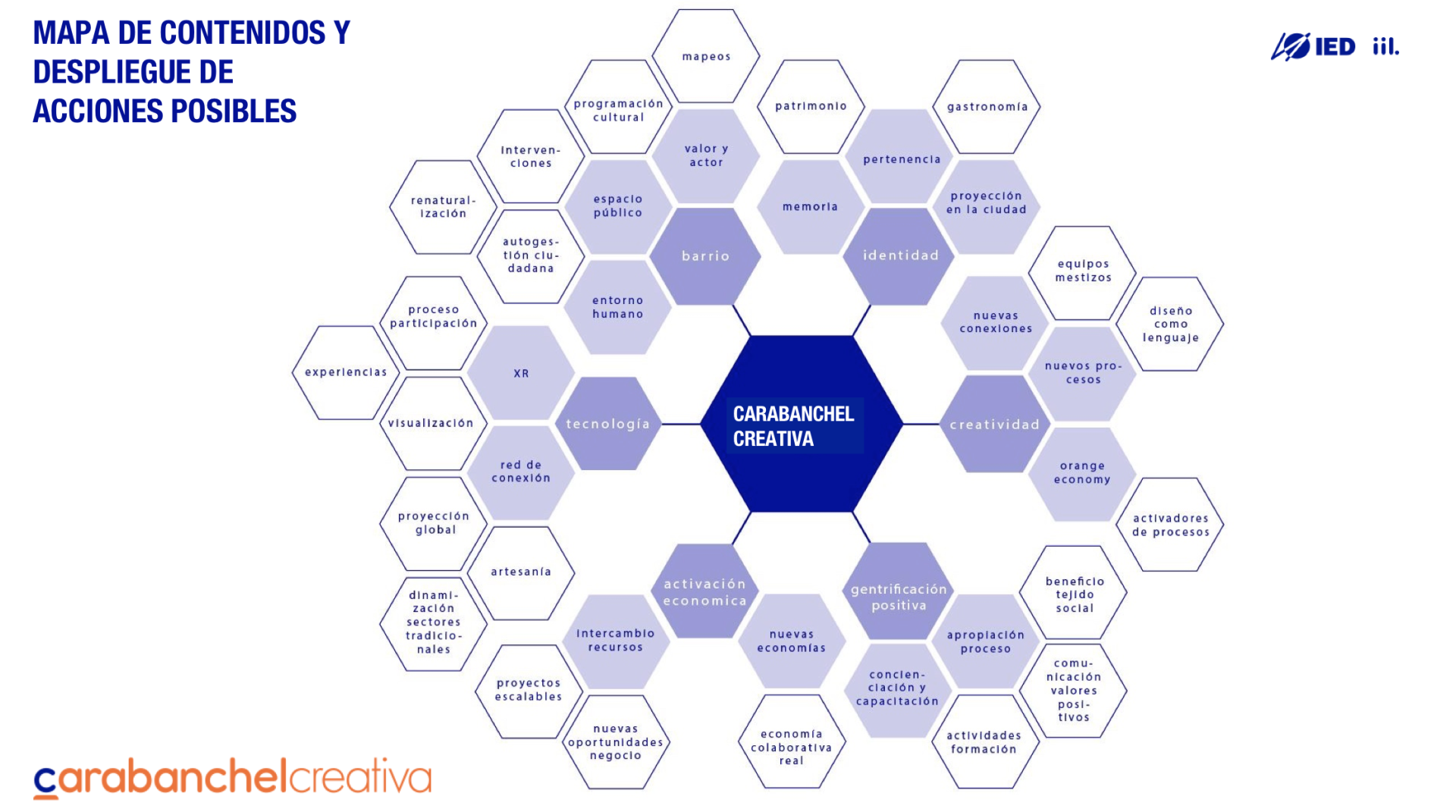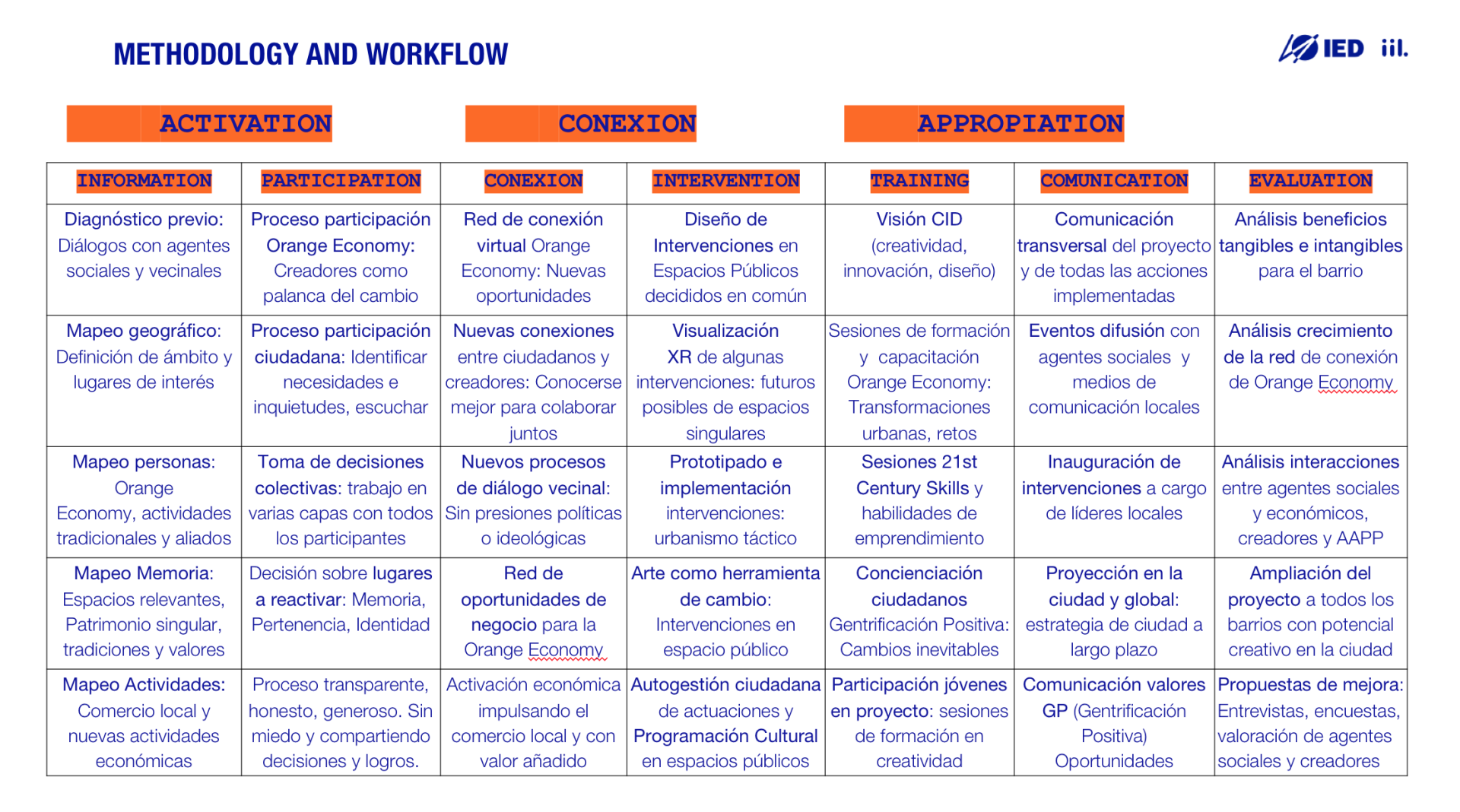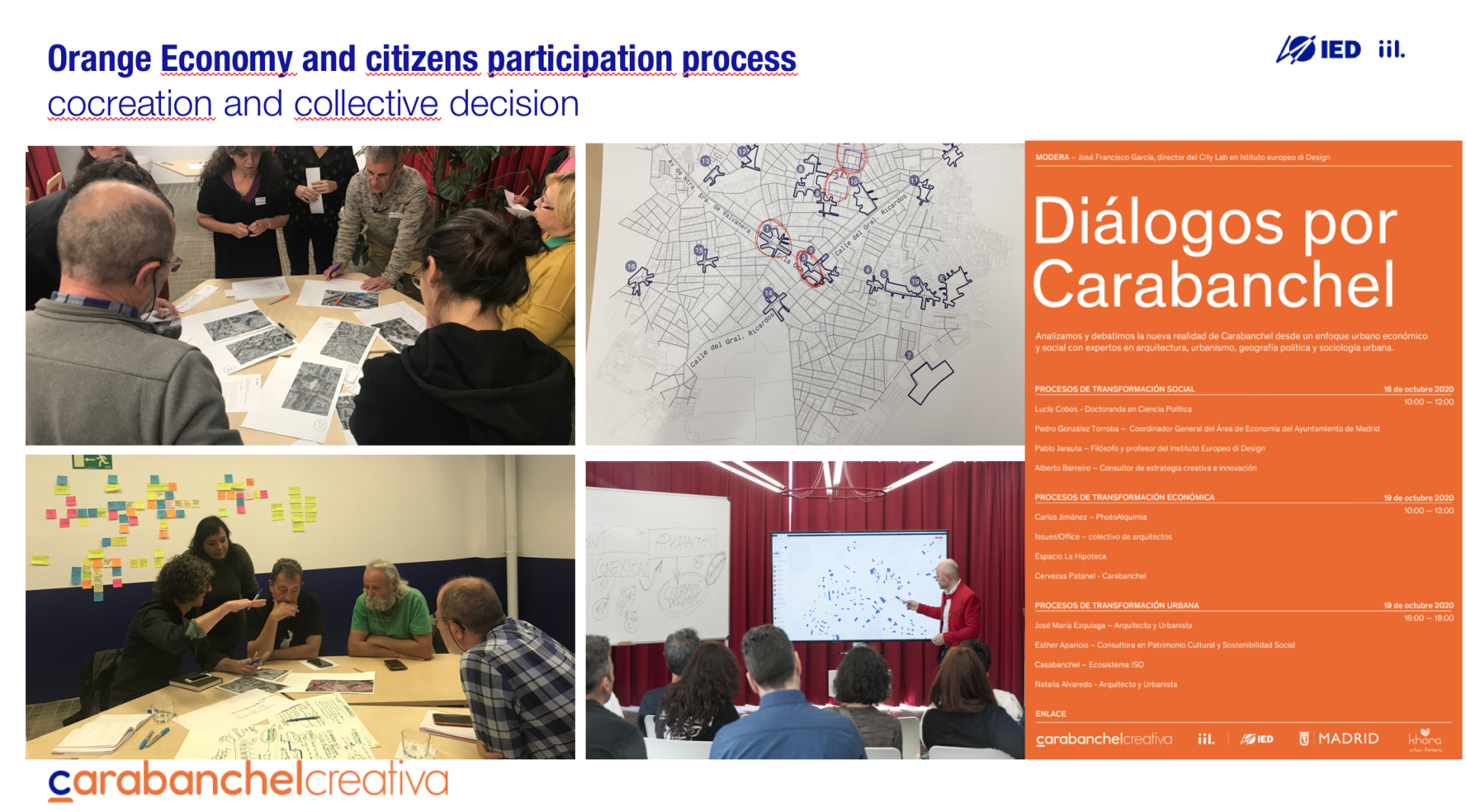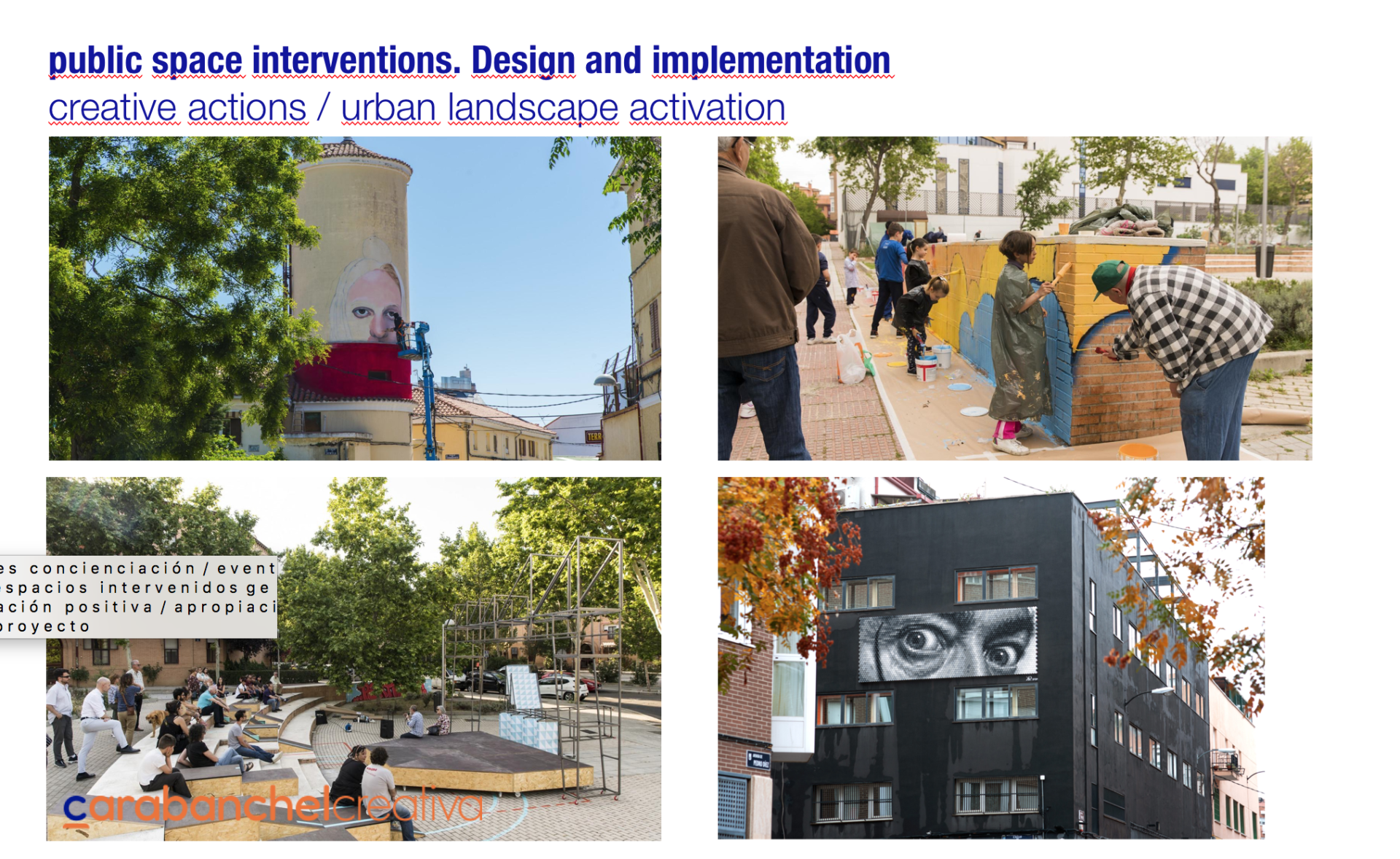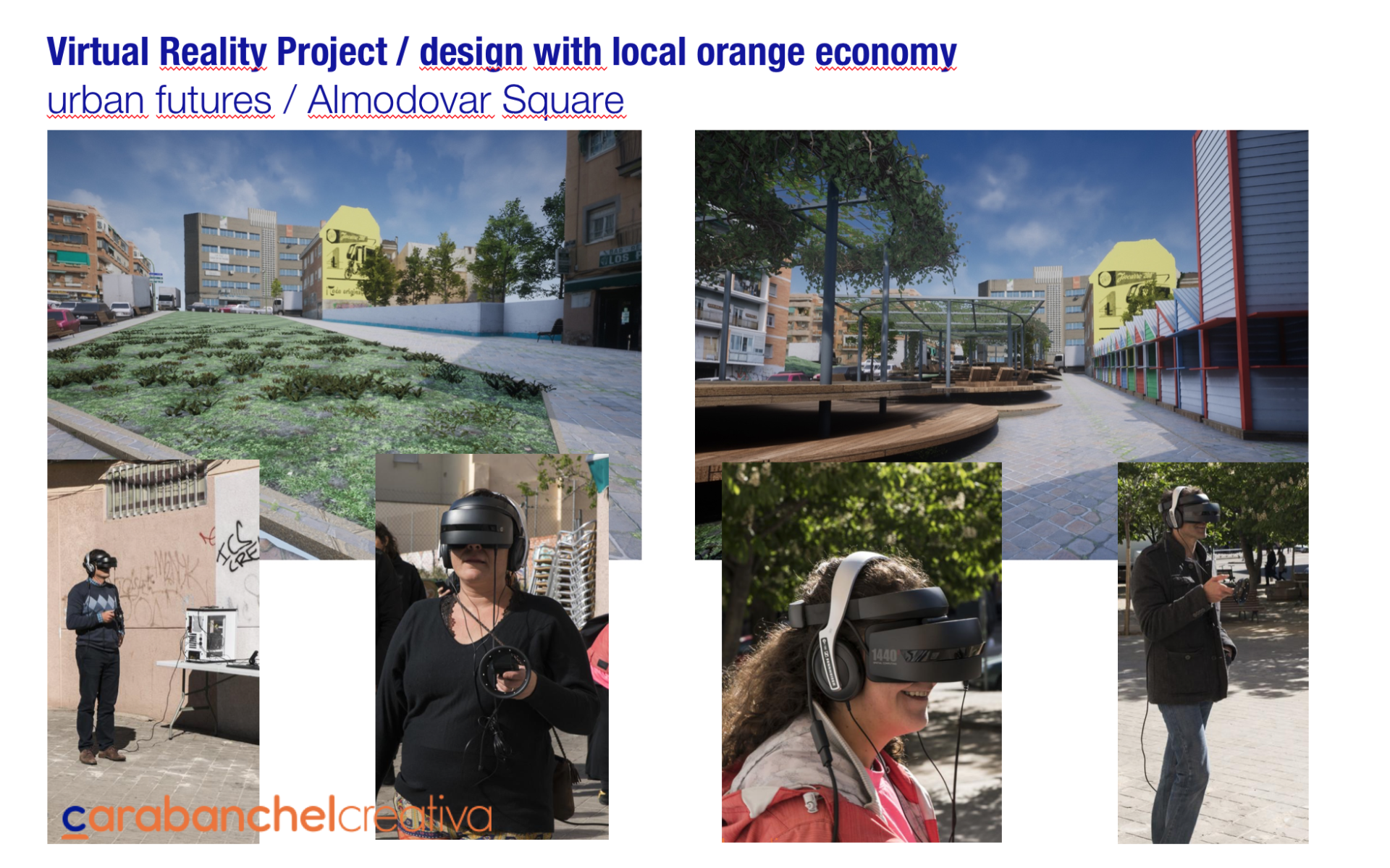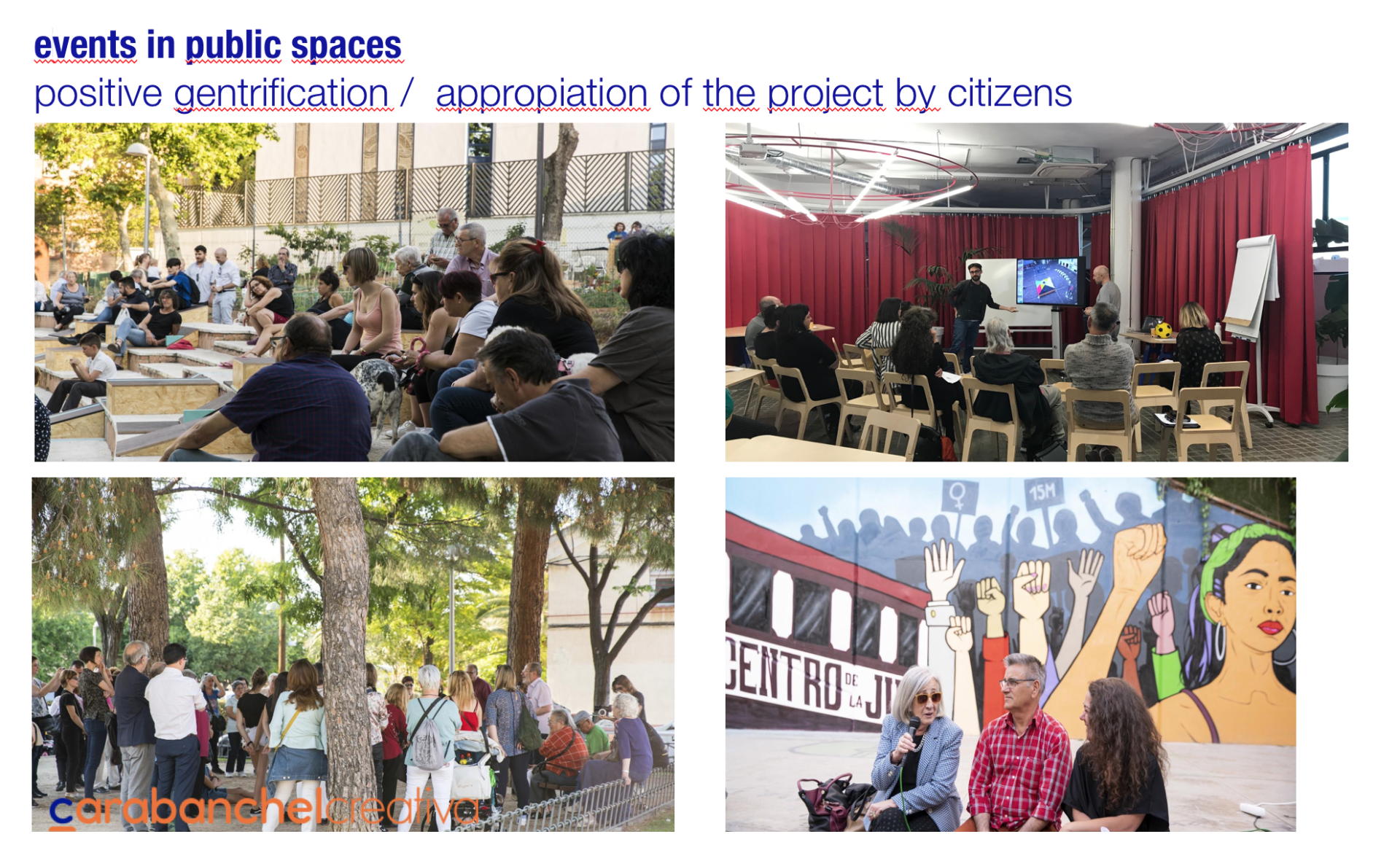Madrid Creativa Carabanchel
Basic information
Project Title
Full project title
Category
Project Description
Carabanchel Creativa seeks to achieve social, cultural and economic activation in the neighborhood of Carabanchel in Madrid, through the Orange Economy, creativity, citizen participation, new visualization technologies and digital connection, using the neighborhood as a laboratory for creation and experimentation. With its own methodology in 8 phases of action.
The key concepts of the project are: ACTIVATION of processes, CONNECTION of people, APPROPRIATION of the results by the people.
Project Region
EU Programme or fund
Description of the project
Summary
Carabanchel Creativa is the IED InnovationLab project to achieve social, cultural and economic activation in the city through the connection of people, places and memories of the neighborhood, applying design, creativity and technologies, to generate processes of social and economic improvement , and increase the positive effects of urban gentrification processes.
The engine of change is the creative economy or orange economy, a group made up of conscientious people who are involved in improving their environment. The methodology was designed to act on the complexity of an urban space with multiple layers.
The Carabanchel Creativa project is the demonstration that design can lead transformation processes in the city, the most demanding and dynamic context that exists. With the participation of diverse professionals, in horizontal and generous mixed-race teams. It is a project with a global view of reality, and with live action content.
After a mapping process designed especially for the project, we developed a virtual platform for connection between the orange economy, to generate new economic opportunities for them. In addition, we work with the neighborhood community, we decide together which spaces we can reactivate, and we apply new features, such as the design of possible futures in Virtual Reality. We talk about the reality of the future of the neighborhood, we talk about positive gentrification, we intervene in some important urban landscapes to give them visibility, and we promote self-management of the intervened spaces.
The scale of action was the neighborhood, a concrete urban reality, settled, known and with its own identity. Technology and creativity were our tools, and from the beginning we looked for social and economic improvement effects, for the neighborhood and for the community.
Key objectives for sustainability
SUSTAINABLE AND PARTICIPATORY ART. Carabanchel Creativa works to raise awareness among citizens about the need for recycling and awareness of the responsible use of our resources. Through a participatory mural artistic intervention in collaboration with artistic groups and citizens of the neighborhood.
PIXELATA CARABANCHEL CREATIVA
PIXELATA consists of creating a large-format pixelated image, using recycled beverage cans and painted on their base.
More info: http://www.photoalquimia.com/pixelata.html
The installed piece is a Street Art installation, made with the pixelation technique, in grayscale, black and white (9 colors), developing an approximate canvas of 190 x 535 cm. using 3,000 recycled cans, the same that are consumed in Spain every 10 seconds.
The mural is inspired by a well-known portrait of the artist Salvador Dalí and focuses on the expression of his gaze, as an iconic image of art, recognizable practically by most people.
The mural was permanently installed on a facade in the Carabanchel neighborhood, as a piece of Street art, with the aim of providing the public space with an artistic intervention in which residents who have participated in the dynamics of recycling beverage cans necessary for its realization and feel the piece, as something of their own.
The reason for working on this material is due to the infinite recycling capacity that an aluminum can has, being an excellent example to transform the concept of garbage into a valuable resource and understand concepts such as recycling and the circular economy.
The piece is totally sustainable and recyclable. The day you want to remove it, you only have to melt it to get 50 kg of aluminum, integrating this material again in the circular cycle, to make as many new cans, reducing energy consumption, water and greenhouse gases.
Key objectives for aesthetics and quality
El resultado de las intervenciones puede verse en los vídeos y las fotografías de sus autores. Fueron intervenciones de gran calidad hechas por distintos profesionales:
PhotoAlquimia, La Higuera y el Almendro, Jardín de los Libros Nómadas, Esther F. Castelo, SG, Ysra, Serone, KRBC Art Project Space, AV General Ricardos, , Matilda, El Observatorio, Gruta 77, Jardín de los Libros Nómadas, Casabanchel, María Tolmos, Sálvora Feliz, Juan Tur, Noemí Díaz, Laura González Caballero, Beatriz López Herraiz, Berta Ribaudí i Compte y Álvaro del Río, Conjuntos Empáticos, Juan José García Geijo, Lourdes Cabrera. Irene R. Vara.
Design of structures to space public: Itinerant Office Architects, leading by Gianpiero Venturini.
Development of Digital actions:
Head of the team: Javier Maseda
Product Design: Javier Maseda & Sandra Rueda
Branding, Visual Identity & visual design: Margo Nova
UX: Gustav Dybeck, Rohit Gupta
Research: Farrel Lee, Gustav Dybeck, Carlos
Research & data visualization: Rohit Gupta
FrontEnd & web design & Visualization: Carlos, Lucas
Key objectives for inclusion
The work process involved all neighborhood associations in the neighborhood, which means that all groups are represented in decision-making. There was no specific activity with groups in need of inclusion, but with the associations that represent them and that work with them regularly.
The participating associations were:
AV Tercio Terol, AV San Isidro, AV Camino Alto De San Isidro, Grupo de Mujeres de Carabanchel, Servicio de Dinamización Vecinal de Camino Alto de San Isidro, San Isidro y Comillas, Ecosistema ISO, Asociación Carabanchel Distrito Cultural.
Results in relation to category
5 neighborhoods of the Carabanchel district included in the project (Opañel, San Isidro, Comillas, Vista Alegre, Puerta Bonita).
More than 150 members of the Orange Economy mapped
More than 200 references of industrial heritage
More than 400 local trade references
More than 300 references of traditional activities
22 reactivated spaces / 8 intervened spaces / 1 space created in VR
20 meetings with social agents and creators
5 opening events and presentation of interventions in public space
65 professionals and artists participating in the interventions
More than 350 people from the neighborhood attending awareness and presentation sessions
How Citizens benefit
The process of citizen participation that is developed, ends with the decision of the most interesting spaces to intervene in the neighborhood, and the needs that the project can help to solve, raised by the neighborhood associations and neighborhood groups. It is assessed which artists or professionals are the most suitable to develop the interventions, and they are carried out in collaboration with the groups involved.
Several artistic interventions of Street Art were carried out, in an abandoned water tank that means a lot for the heritage identity of the neighborhood, on a wall located in the square where the first demonstration against gender violence in Madrid was held, and in a space public deteriorated but located in a strategic place. In addition, a portable stage was built so that neighborhood associations can organize musical performances and cultural shows in different parts of the neighborhood. All with great aesthetic and functional results, generating utility for neighborhood associations and citizens.
Over 350 people from the neighborhood attended our awareness sessions and presentations.
And they have been intervened in 8 spaces that the citizens themselves decided and chose.
Innovative character
Methodology and work phases:
Information, which includes a part of diagnosis, geographical mapping, mapping of traditional activities, orange economy or possible project partners.
Participation, a participatory and collective decision process with members of the orange economy and citizens, including a compilation of the memory of the most emblematic places in the neighborhood.
Connection, through the design and implementation of a digital connection platform that collects all these mappings, and that includes in-depth work on prior knowledge and usefulness and functionality:
Creation of the map on which all the users of the platform are displayed.
Filter and user search by type, allies, orange and traditional
Filter and Search for Industrial Heritage and Places of Interest.
Visualization of the data in file of each one of the different elements.
Intervention, in public space, with the design of actions to improve some public spaces, through temporary or artistic interventions, which demonstrate the capacity of these places to host new activities or that improve their image among citizens. Prototyping and implementation of all interventions. In this phase, we also design a virtual intervention in Plaza Almodóvar, with the creation of a Virtual Reality environment of a possible future for the plaza, designed in the process of participation together with artists and neighbors.
Training, with the holding of several sessions in which the project's values are transmitted to the project participants, in addition to making them aware of the upcoming changes in the neighborhood, and the opportunities that may arise with the appearance of new inhabitants and new urban economies that will emerge in the area.
Communication, with the organization of various communication events of the positive values of the project and the neighborhood, and the projection that the project has.

